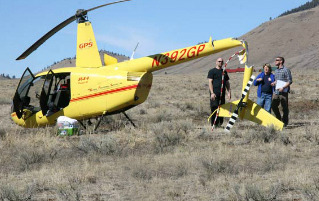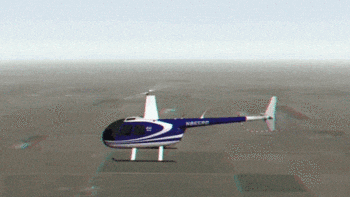5 Things Only Helicopter Pilots Know About The World

Helicopters might not be the fastest or cheapest way to travel, but they're undeniably the coolest (albeit also the most explosion-prone, if pop culture has taught us anything). We talked with certified copter pilots Christopher Ross, Adrian Pierre Pihl Spahiu, and Zaron Welch, who told us what it's like to fly giant hunks of metal powered by spinning knives for a living. They said ...
A Helicopter Can Easily Chop Itself In Half

As anyone who's crashed a helicopter in Grand Theft Auto V 10 seconds after getting into it knows, these machines are so precise that in the hands of an unskilled pilot, they can be brought down by, well, nothing at all. Let's take wind, for example. A helicopter essentially hangs from its blades, so if it gets too windy, and the pilot is too rough, the tail section can hit the blades and get sliced clean off:

"Well, folks, you're about to get a VIP close-up view of the Grand Canyon."
"The rotor blades are not fixed rigidly to the helicopter," Chris explained. "Only centrifugal force keeps them in the position you see, so during severe turbulence the motion can push the tail boom up around and into the blades. That's bad. The best way to counteract it is stop fighting the helicopter and let it bob around in the sky waves."
If that sounds hard, that's because it absolutely is -- Chris likened it to learning to juggle on a unicycle on top of a beach ball. And if that's too whimsical for you, here's what it looks like when that juggling lesson fails:

"We're gonna need a lot of duct tape."
Adrian told us that sometimes even a simple shift in weight can be catastrophic, and that's not even a setup for a joke about your mom. "I was supposed to fly a family of four around town. What I didn't know was that while I was getting ready, the family decided it would be best to let one of the girls sit by the left-hand window, and instead the father had seated himself behind me on the right-hand side."
So one side of the helicopter ended up way heavier than the other, and that's all it took. "The rear and left side of the helicopter took off, while the right and forward part did not. Thankfully, the worst that happened was that we drifted a bit before the helicopter fell back onto its skids."

Worst-case scenario, the skids land about a mile downfield.
In a much more extreme example, like if your ... elephant had been onboard, the helicopter could have upended completely. Honestly, we truly are flipping Mother Nature off every time one of these machines completes a flight instead of crashing to the ground like the weird mechanical abomination it is.
Pilots Can (And Often Do) Land In Fast Food Parking Lots

You'd think that there would be more rules governing the use of helicopters than other aircraft because of the former's whole exposed-blender design. In reality, though, unlike airplanes, helicopters have almost no landing zone limitations. If the big spinny part fits, they can land.
Christopher told us they deal with so little red tape that, among other perks, they can land pretty much wherever they want. "In general, the rules for helicopters are less restrictive due to our landing requirements (no runways needed). Put extremely simply, I can land anywhere as long as I'm not violating an existing rule (like a wildlife bird refuge or a military base) and not endangering myself or others ... I once flew from Hillsboro to Tillamook in Oregon, landing on sand at the edge of a river just for fun."
While pulling a reverse Jaws by terrifying everyone on land would be fun, the most gratuitously awesome use of a helicopter has got to be the $100 fast food run.

"If I want In-N-Out, I'm getting In-N-Out."
"Some folks I knew would take a Robinson 22 up into the hills of Vernonia, OR, and land in the back of a Dairy Queen parking lot to get a burger." At that point we hung up on Christopher and started shopping for an office helicopter, because that gave us so many ideas. Liven up any house party by going on a beer run in your chopper. Head to the roof of the local mall and play Dawn Of The Dead. Fly to a paintball field and introduce the "Vietnam" scenario. Hell, if we owned a helicopter, we'd fly it from the backyard to the front to check our mailbox.
Fantasies aside, the relaxed landing rules are there to help save lives (and because even government bureaucrats can appreciate a good helicopter lunch run). Adrian explained, "Once I got stuck in bad weather and had to make an emergency landing in a small meadow in the forest. There was one lonely house there and the owners were quite surprised to see a helicopter land in their backyard. Try doing that with an airplane."
Don't actually try that. You would crash and die, because this is how tight a helicopter's landing spot can get:

Throw in your Uncle's handicap plates so you can grab the best spots.
Sure, it's not exactly a back alley, but good luck cramming a 747 onto that. Now pretend there are cars all around the helicopter, and at least one person walking through with a takeout bag.
You Can Fly Surprisingly Far With A Dead Engine

Much like a video game boss, it's easy to spot a helicopter's fatal weak spot: the rotor blades.

Looks like you could take it down with a sturdy broom handle.
Take those out, and the entire machine will come crashing down as hard as, well, any video game helicopter. But that's only true if you blow the blades clean off -- as long as they remain attached, a copter with a broken engine can land safely thanks to something called autorotation. We assumed that's what you called a masturbating helicopter until Chris explained the details. "The concept is simple," Chris lied. "In normal operation, you are using the engine to drive the rotors. That, in turn, creates lift above the rotor disc, and you are pulled up because the air pressure above the spinning rotor is lower than below, so you have lift."
Basically, the spinning blades create a region of low pressure, which "lifts" the helicopter into the air. But once you're in the air, and you tip the copter back at the right angle, Chris says that you can shut the engine off and use your altitude and airspeed to spin the blades naturally without any outside power, which is commonly known as witchcraft.

Turns out the air vehicles do not immediately explode if you let go of the throttle.
"In an autorotation, you tilt the rotor backwards so air starts rushing up through the blades, turning them like a pinwheel. That creates lift, so you stay up. You need to first have some type of energy in the system (usually from the engine), to convert into rotational energy, but once you have that, you can turn the engine off and land by having the rotors 'pinwheeling.' When done correctly, passengers would likely not even know that the engine was off."
Great, that's comforting. They're an emergency maneuver, but they're a commonly practiced one. "You do ALL THE TIME when training. Honestly, I've done 200." For an example, check out the video below and start screaming or praying when the pilot turns the engine off to capture the feeling of being there.
You'll Be Hired To Be A Giant Blow-Dryer

One of the great things about money, or so rich people tell us, is that once you have enough, you no longer have to abide by common sense when solving a problem. Adrian gave us a case in point: "One of the stranger helicopter jobs I was asked to do was drying the greens on a golf course. They had had problems with a lot of raining during the spring and the greens were soaking. So they asked us to hover for a few minutes above each green, sort of like a giant $2,000-an-hour hairdryer."
This is opening up a new realm of possibilities for our office helicopter. Why waste good money on a wave pool when we could buy a regular pool and a helicopter? Zaron did something similar for his first job out of flight school. "I went to dry cherries with a farmer in central Washington who had around 300 acres of cherry trees. During the summer, thunderstorms can roll in. All the extra water pools around the stems of the cherries, which is bad because if they soak up too much water, they will split open and spoil. Our job was to hover low over the cherries and shake the water off of them."

$150,000 worth of equipment to bring you 50 cents worth of fruit.
Imagine spending hundreds of hours mastering one of mankind's most badass technological marvels and then, instead of shuttling around powerful dignitaries or going on dangerous rescue missions, you're keeping cherries from being popped. It gets better though -- Zaron moved on to fighting forest fires with helicopter fire.
"Wildfires are awful when they affect people, but when you're working on a fire that you're trying to keep from getting bigger so it doesn't threaten something, it's a lot of fun. It's even better when you get to fight fire with more fire! We have giant drip torches we can hang under the helicopter to burn up fuel in front of the fire, stopping it in its tracks."

Is there anything more badass than literally fighting fire with fire?
That's right, nature. You think you can burn a forest down? We'll burn it down even better, from the sky. Helicopters are also great for strategically scaring the crap out of wild animals (generally for their own good, occasionally for fun on the weekends), in an additional act of defiance against nature. "In the north of Scandinavia, you herd reindeer," says Adrian. "You attach a megaphone to the helicopter and fly around the herd in order to move them in the right direction." We assume "the right direction" is "back toward Santa's workshop after a failed attempt to escape his harsh labor regime."
Finally, helicopters are used to look for gold and other valuables by attaching giant metal detectors to them, which happens to make them look like UFOs carrying a human-catching net.

"CITIZENS. DO NOT PANIC. PLEASE ENTER THE NET IN AN ORDERLY FASHION."
A Helicopter Will Help You Get In Touch With Nature (No, Really)

Humanity's always dreamed of flying, but with all due respect to planes, the real dream is all about being free to go anywhere you want, like some kind of, uh ... animal that can fly. A dog with wings, maybe. And until jetpacks become slightly more affordable and real, helicopters are the best way to achieve that freedom. Just witness Adrian talking about his first solo flight:
"There I was, in the middle of nowhere, all alone 1,000 feet up in the air, and it was the most unbelievable feeling. Being above everything gives you a very different perspective. You can fly 400 feet above your home and barely recognize it. With a helicopter, you don't get that 'It's all a flat carpet far far below us' feeling you get on an airplane. You feel the presence of the world below you."

"TOO CLOSE TO THE BEAUTY OF MOTHER NATURE! PULL UP!"
And then, if you're getting hungry, you can search the presence for a burger joint. Hell, you can go down for a closer look at anything you want, as Zaron explained. "I've flown over northern Louisiana right after sunrise in the summer, doors off, calm winds. Just me and the helicopter on a magic carpet above valleys filled with fog and trees and the fresh air to keep me cool. I've seen the sunset over the ocean from 1,000 feet above the city. I've parked on the side of Mount Rainier and had my lunch on a glacier with clear blue skies. I've seen some of the most remote valleys in the Sierras. I once flew by some hikers, up around 13,000 feet, who had probably been hiking for days. I could have landed right next to them to say hi. Meanwhile, I was in shorts and flip flops, coffee in my hand, and a mere two hours prior I had been two states away in bed at my hotel."
In conclusion, Cracked is going on hiatus for a few weeks while we all take helicopter lessons. You understand.

"Ugh, what happened."
"You tripped on the tarmac."
Christopher Ross doesn't get to fly as often as he'd like these days, but like every other pilot in the world, he loves to talk about it. If you'd like to know more, contact him at WillYouActuallyTypeThis@gmail.com. Adrian holds an EASA CPL (Commercial Pilot License), but ran out of awesome and now spends most of his time at the university telling other students about how he used to be badass. Zaron Welch is a utility helicopter pilot flying mostly search and rescue, firefighting, and helicopter construction jobs. Cezary Jan Strusiewicz is a Cracked columnist, interviewer, and editor. Contact him at c.j.strusiewicz@gmail.com.
Cracked is up for TWO Webby Awards, for Best Humor Site and Best Video Entertainment! While we're busy patting ourselves on the back, you can pat too by voting here and here.
For more insider perspectives, check out 4 Horrifying Things I Learned Drunk At Work As A Stunt Man and Fast & Furious Is Full Of It: 5 Racecar Driver Realities.
Subscribe to our YouTube channel, and check out another 4 Hilarious Behind The Scene Details of a Movie Sex Scene, and watch other videos you won't see on the site!
Also, follow us on Facebook, and let's go ramp a helicopter.
Have a story to share with Cracked? Email us here.
